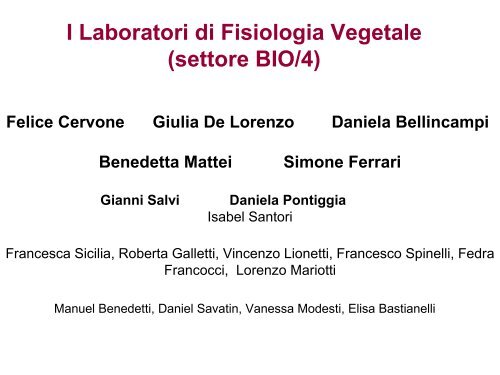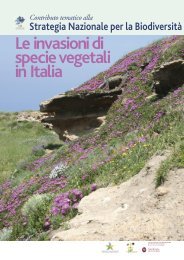I laboratori di fisiologia vegetale (settore bio/4
I laboratori di fisiologia vegetale (settore bio/4
I laboratori di fisiologia vegetale (settore bio/4
You also want an ePaper? Increase the reach of your titles
YUMPU automatically turns print PDFs into web optimized ePapers that Google loves.
I Laboratori <strong>di</strong> Fisiologia Vegetale<br />
(<strong>settore</strong> BIO/4)<br />
Felice Cervone Giulia De Lorenzo Daniela Bellincampi<br />
Benedetta Mattei Simone Ferrari<br />
Gianni Salvi Daniela Pontiggia<br />
Isabel Santori<br />
Francesca Sicilia, Roberta Galletti, Vincenzo Lionetti, Francesco Spinelli, Fedra<br />
Francocci, Lorenzo Mariotti<br />
Manuel Benedetti, Daniel Savatin, Vanessa Modesti, Elisa Bastianelli
Laboratori <strong>di</strong> Biologia Molecolare e Biochimica<br />
HPLC Dionex ICS3000<br />
Fon<strong>di</strong> ERC<br />
Fluorimetro/Luminometro<br />
Fon<strong>di</strong> ERC<br />
HPLC AKTA Purifier<br />
Fon<strong>di</strong> Armenise-Harvard<br />
Real Time PCR Biorad<br />
Fon<strong>di</strong> ERC
Attrezzature per colture <strong>di</strong> cellule vegetali e piante<br />
transgeniche<br />
Serra<br />
Fon<strong>di</strong> Armenise-Harvard<br />
Camera <strong>di</strong> crescita
Piattaforma tecnologica per proteomica, metabolomica<br />
e analisi <strong>di</strong> polisaccari<strong>di</strong> complessi<br />
BiacoreX<br />
MALDI-TOF-MS<br />
Contributo Armenise-Harvard<br />
5000<br />
4000<br />
3000<br />
2000<br />
1000<br />
0<br />
25500<br />
25000<br />
24500<br />
24000<br />
Response RU<br />
23500<br />
File # 4 = C:\UNIPRG\DATA\V36654CS.MS Collected: 18-08-98 14:22Sample: 47<br />
6000<br />
Counts<br />
500 550 600 650 700<br />
Laser : 1400<br />
Mass (m/z)<br />
Comment: Saq elu HIV-p 980818, <strong>di</strong>rect elu 45% HCCA<br />
23000<br />
0 50 100 150 200 250 300 350 400 450 500<br />
Time s<br />
671.4<br />
Orbitrap nanoESI-LC-MS<br />
Fon<strong>di</strong> ERC.<br />
2D- DIGE
Progetti finanziati<br />
PRIN<br />
2005052297, 2007-2009 65.950 euro<br />
2007K7KY8Y 2007-2009 38.890<br />
2007-2009 27.000<br />
2006-2007 37.500<br />
2005-2007 27.000<br />
Ateneo 2006-2008 104.000<br />
Institute Pasteur- Cenci Bolognetti 2005-2007 66.400<br />
Institute Pasteur- Cenci Bolognetti 2008-2010 60.000<br />
Unione Europea Wallnet MRTN-CT-2004-512265 2005-2008 180.000<br />
C.R.A - Ministero Agricoltura, Proteostress 2006-2009 385.000<br />
C.R.A - Ministero Agricoltura, Fitolisi 2010-2012 237.000<br />
C.R.A - Ministero Agricoltura, Alisal 2010-2012 35.000<br />
FIRB 2005-2010 491.000<br />
FIRB-EU, ERA-PG 2007-2010 258.000<br />
Europ Res Council (ERC) Advanced Grant 2009-2013 n. 233083 2.100.000
Federici et al., (2001) PNAS 98, 13425-13430.<br />
De Lorenzo et al., (2001) Annual Review of Phytopathology. 39, 313-335.<br />
De Lorenzo, S. Ferrari (2002) Current Opinion in Plant Biology 5, 295-299.<br />
Ferrari et al. (2003) Plant Journal 35, 193-205 – 218<br />
Di Matteo et al. (2003) PNAS 100, 10124-10128.<br />
Ferrari et al.(2003) Plant Cell 15, 93-106.<br />
Capo<strong>di</strong>casa et al.(2004) Plant Physiology 135: 1294-1304.<br />
D’Ovi<strong>di</strong>o et al.(2004) Plant Physiology 135, 2424-35.<br />
Guyon et al. (2004) Plant Journal 39, 643-54.<br />
Di Matteo et al. (2005) Plant Cell 17: 849-858.<br />
Sicilia et al. (2005) Plant Physiology 139,1380-1388.<br />
Federici et al.(2006)Trends in Plant Science 11: 65-70.<br />
Spadoni et al.(2006)Plant Physiology 141, 557-564.<br />
Lionetti et al. (2007) Plant Physiology. 143, pp. 1871-80.<br />
Nar<strong>di</strong>ni et al. (2007) Plant Physiology 143, pp. 1975-1981.<br />
Ferrari et al. (2007) Plant Physiology 144, 367-379.<br />
Casasoli et al., (2008) Proteomics 8, 1042-1054.<br />
Ferrari et al., (2008) Plant Physiology 146, 669-681.<br />
Denoux et al., (2008) Molecular Plant 1, 423-445.<br />
Galletti et al.(2008) Plant Physiology 148, 1695-1706. -<br />
Casasoli et al.(2009)PNAS 106, 7666-7672<br />
Lionetti et al (2009) PNAS (in corso <strong>di</strong> stampa)
• Brevetto n. RM2003A000346 “Inibitore della pectina metilesterasi nella<br />
preparazione dei succhi <strong>di</strong> frutta e derivati” .<br />
• Brevetto n. PD2007A000065 “Uso <strong>di</strong> un inibitore proteico della pectinmetilesterasi<br />
per la riduzione della formazione <strong>di</strong> metanolo in mosti <strong>di</strong> uva e vinacce e<br />
processo per la stessa”<br />
– Estensione europea del brevetto n. PD2007A000065 “ Use of protein inhibitor of<br />
pectin methylesterase for reducing methanol formation in grape must and<br />
marc, and process therefor” International application n. PCT/EP2008/052347<br />
• Brevetto n. RM2008A000696 “Uso <strong>di</strong> piante con un ridotti livelli <strong>di</strong><br />
omogalatturonano de-esterificato nella parete cellulare o parti <strong>di</strong> esse per<br />
migliorare la saccarificazione <strong>di</strong> <strong>bio</strong>masse vegetali”<br />
– Approvazione <strong>di</strong> procedura <strong>di</strong> estensione europea del brevetto n.<br />
RM2008A000696<br />
• Brevetto n. RM2009A000279 “Costrutti esprimenti recettori chimerici e loro uso<br />
per l’attivazione controllata delle risposte <strong>di</strong> <strong>di</strong>fesa a microrganismi patogeni in<br />
pianta”
PLANT CELL WALL<br />
in<br />
Plant Innate Immunity<br />
Recognition Transduction Response<br />
Plant growth and development<br />
Biotechnological application<br />
Resistance to pathogens Food processing Biofuel
How <strong>di</strong>d flowers evolve?<br />
Darwin called this question an "abominable mystery." Flowers arose in the cycads and conifers, but<br />
the details of their evolution remain obscure.<br />
How do plants make cell walls?<br />
Cellulose and pectin walls surround cells, keeping water in and supporting tall trees. The<br />
<strong>bio</strong>chemistry holds the secrets to turning its <strong>bio</strong>mass into fuel.<br />
How is plant growth controlled?<br />
Redwoods grow to be hundreds of meters tall, Arctic willows barely 10 centimeters. Understan<strong>di</strong>ng<br />
the <strong>di</strong>fference could lead to higher-yiel<strong>di</strong>ng crops.<br />
Why aren't all plants immune to all <strong>di</strong>seases?<br />
Plants can mount a general immune response, but they also maintain molecular snipers that take<br />
out specific pathogens. Plant pathologists are asking why <strong>di</strong>fferent species, even closely related<br />
ones, have <strong>di</strong>fferent sets of defenders. The answer could result in har<strong>di</strong>er crops.<br />
What is the basis of variation in stress tolerance in plants?<br />
We need crops that better withstand drought, cold, and other stresses. But there are so many<br />
genes involved, in complex interactions, that no one has yet figured out which ones work how.
PGIPs: leucine-rich repeat extracellular proteins for<br />
recognition of non-self polygalacturonases<br />
MAMMALS PLANTS<br />
PG<br />
PGIP<br />
Pto
Three-<strong>di</strong>mensional structure of PG from<br />
Fusarium moniliforme<br />
Federici et al. 2001, PNAS<br />
Parallel β-helix fold
MSSSLSIILVILVSLRTAHS<br />
ELCNPQDKQALLQIKKDLGNPTTLSSWLPTTDCC CCNRTWL<br />
NNLDLSG.LNLPKPYPIPSSLANL.PYL lrr1<br />
NFLYIGGINNLV..GPIPPAIAKL.TQL lrr2<br />
HYLYITH.TNVS..GAIPDFLSQI.KTL lrr3<br />
VTLDFSY.NALS..GTLPPSISSL.PNL lrr4<br />
VGITFDG.NRIS..GAIPDSYGSFSKLF lrr5<br />
TSMTISR.NRLT..GKIPPTFANL..NL lrr6<br />
AFVDLSR.NMLE..GDASVLFGSD.KNT lrr7<br />
QKIHLAK.NSLA..FDLGKVGLS..KNL lrr8<br />
NGLDLRN.NRIY..GTLPQGLTQL.KFL lrr9<br />
HSLNVSF.NNLC..GEIPQG.GN lrr10<br />
YANNKCLCGSPLPACT<br />
B1-sheet B2-sheet<br />
3 10 -helix<br />
xxLxLxx.NxLx..GxIPxxLxxL.xxL<br />
\<br />
xxLDLSS.NNLx..GxIPSxLxxL.xxL Cf-9<br />
xxLDLSS.NNLx..GxIPxxLxxL.xxL Xa21<br />
xxLxLSx.NxLS..GEIPxxLxxL.xxL RLK5<br />
xxLxLSx.NxaS..GxIPxxaxxx.xxL BRK1<br />
xxLxLxx.NxLx..GxIPxxaxxx.xxL CLAVATA<br />
QxLxLxx.NNLS..GxaPxxLxxL.xxL TMK1<br />
310-helices<br />
B2-sheet<br />
PvPGIP2<br />
C-ter<br />
N-ter<br />
Di Matteo et al, PNAS, 2003<br />
B1-sheet
LePME1 AcPMEI<br />
(Di Matteo et al., Plant Cell 2005)<br />
• Four Helix Bundle” of the<br />
inhibitor<br />
• 2 <strong>di</strong>sulphide bridges necessary<br />
to maintain fold<br />
• 1:1 stoichiometry<br />
• Inibitors bind active site of<br />
PME preventing substrate<br />
bin<strong>di</strong>ng
PG plants have dwarf phenotype<br />
Tabacco<br />
Arabidopsis<br />
#1<br />
wt #5 #7 #16 PG#16 x<br />
PvPGIP2<br />
#5<br />
Col-0<br />
PG201<br />
#4<br />
PvPGIP2<br />
#1 Ws-0<br />
-PG plants have a reduced content of HGA
AtPMEI overexpression enhances <strong>bio</strong>mass production<br />
Dry weight (mg)<br />
20<br />
15<br />
10<br />
5<br />
0<br />
WT AtPMEI<br />
*<br />
***<br />
WT 1.5 2.9<br />
Fresh weight (mg)<br />
220<br />
200<br />
180<br />
160<br />
140<br />
120<br />
100<br />
80<br />
60<br />
40<br />
20<br />
0<br />
H2O content (%)<br />
100<br />
90<br />
80<br />
70<br />
60<br />
50<br />
40<br />
30<br />
20<br />
10<br />
0<br />
*<br />
***<br />
WT 1.5 2.9<br />
WT 1.5 2.9
Cellulose Hemicellulose Pectin<br />
xyloglucan<br />
galactomannan<br />
arabinoxylan<br />
Homogalacturonan<br />
Ca2+-crosslinked<br />
non-methylesterified<br />
methylesterified<br />
RG I<br />
(galactan) (arabinan)<br />
Pectin<br />
Rhamnogalacturonan<br />
RG II<br />
(boron-<strong>di</strong>ester)
Cellulose Hemicellulose<br />
The Plant Cell Wall<br />
xyloglucan<br />
galactomannan<br />
arabinoxylan
Cellulose<br />
The Plant Cell Wall
Plants <strong>di</strong>gested with cellulase<br />
WT Transformed plants
Plants: a significant proportion of<br />
the <strong>bio</strong>mass on Earth<br />
Cre<strong>di</strong>t: Don Deering, NASA/LBA Project
PLANT CELL WALL<br />
in<br />
Plant Innate Immunity<br />
Recognition Transduction Response<br />
Plant growth and development<br />
Biotechnological application<br />
Resistance to pathogens Food processing Biofuel
- <strong>bio</strong>logy<br />
The PGIP – PG interaction<br />
- structure-function relationships<br />
- co-evolution at the molecular level<br />
of LRR proteins and their ligands
PGIP confers resistance to fungi<br />
Overexpression of PGIP in transgenic plants limits fungal colonization<br />
tomato/Botrytis cinerea : Powell et al. MPMI, 2001<br />
Arabidopsis/Botrytis cinerea : Ferrari et al, Plant Cell, 2003<br />
tobacco/B. cinerea: Manfre<strong>di</strong>ni et al. Physiol. Mol Plant Pathol 2006.<br />
/Phytophthora parasitica var. nicotianae<br />
/Rhizoctonia solani Borras Hidalgo et al. unpublished<br />
wheat/Bipolaris sorokiniana: D’Ovi<strong>di</strong>o et al. MPMI 2007<br />
wheat/Fusarium graminearum D’Ovi<strong>di</strong>o et al. unpublished<br />
Silencing of PGIP in Arabidopsis increases susceptibility to B. cinerea<br />
Ferrari et al, 2006 MPMI
Representation of PvPGIP2 surface with highlighted (A) positively selected sites (ω>1) with<br />
PP >0.95 (green) and with PP >0.80 (yellow), (B) residues showing ODA values lower than –<br />
6.0 kcal/mol (red) and (C) (merged figure) residues with both ODA 1 (PP<br />
>0.80) (cyan)<br />
Casasoli M. et.al. PNAS 2009;106:7666-7671<br />
©2009 by National Academy of Sciences<br />
PG/PGIP coevolution at the molecular level
Plant cell wall<br />
Cell wall integrity sensing in<br />
plants<br />
Pectin: much more than a glue<br />
Oligogalacturonides (OGs)<br />
Ca ++
Oligogalacturonides (OGs):<br />
Damage-Associated Molecular Patterns<br />
(or DAMPs)<br />
•OGs, fragments released from pectin in the plant cell wall, are able to activate<br />
the plant immune system<br />
•No receptor of OGs is known.<br />
Control OG<br />
Botrytis cinerea
OGs are analogous to the hyaluronan fragments released from the extracellular<br />
matrix and involved in the animal innate immunity
Identification of receptors for oligogalacturonides (OGs) using<br />
a chimeric receptor approach<br />
Because reverse genetic approaches for the characterization of the OG receptor are<br />
hampered by lethality and redundancy<br />
LRR extracellular domain (LRR)<br />
External juxta-membrane domain (eJM)<br />
Transmembrane domain (TM)<br />
Internal juxta-membrane domain<br />
(iJM)<br />
Kinase domain (KM)<br />
Proof-of-concept and development of technology<br />
two chimeric receptors based on<br />
FLS2 and EFR<br />
model receptors for PAMP recognition<br />
(flg22 and elf18, respectively)<br />
FLS2/flg22 EFR/elf18<br />
The FLS2-EFR chimeric receptors are functional in transient and stable<br />
expression systems in Arabidopsis and tobacco
(Anderson et al., 2001)<br />
Wall-Associated Kinases (WAKs)<br />
Cromosome 1<br />
Extracellular domains<br />
EGF-like domain<br />
Transmembrane domain<br />
Ser-Thr kinase domain
) Constitutive iRNA-me<strong>di</strong>ated silencing of the gene family<br />
Problem: LETHAL PHENOTYPE<br />
c) Inducible silencing of the gene family<br />
a) Using TDNA insertion germ lines (NASC seeds)<br />
Problem: GROWTH PHENOTYPE<br />
(Wagner et al., 2001 Plant cell)
Using EFR-based chimeras, we identified WAK1 as a<br />
receptor of OGs<br />
Alexandre Brutus<br />
Francesca Sicilia<br />
WAK1 is the first receptor demonstrated to sense the OG signal<br />
The chimeric receptor approach can be used to study the many plant orphan<br />
receptors
Plant cell wall alterations<br />
(cev1)<br />
C<br />
2<br />
H<br />
ETR1<br />
EIN2<br />
4 JA<br />
ERF1<br />
PDF1-2<br />
COI1<br />
Defence<br />
(E. carotovora, B.<br />
cinera)<br />
Thi2-1<br />
VSP<br />
AtPGIP2<br />
Defence<br />
(Phytium sp., A.<br />
brassicicola) and<br />
Wound response<br />
OG/auxin antagonism<br />
Biotic Stress<br />
(pathogens)<br />
SA<br />
NPR1<br />
PR1<br />
AXR1<br />
Defence<br />
(P. syringae, P. parasitica,<br />
Erisyphe sp., B. cinerea,<br />
X. campestris)<br />
Auxin<br />
TIR1, AFBP2,<br />
AFB3 (AFBP2)<br />
Developmental<br />
responses<br />
OG?



